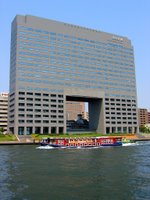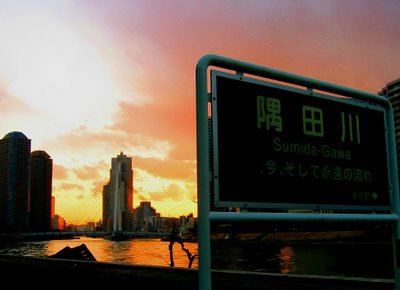My favorite place in Tokyo is not where you’d expect. It’s not in the shade of blooming sakura trees lining Ueno Park. It’s not atop the Mori Tower sky deck. Nor is it on the tranquil grounds of an Edo shrine. Rather, it sits unceremoniously in the shadows, below bustling Tokyo life.
My favorite place is underneath Ryogoku Junction overpass. Here, Expressways 9 (Mukojimasen) and 6 (Komatsugawasen) merge over the Sumida River as vehicles circulate into the beating heart of Tokyo.
The overpass marks the border of Koto and Sumida wards. Sky blue tarpaulins of displaced urban campers color the opposite bank, which lies in Chuo ward. This spot along the Sumidagawa terrace offers glimpses of mundane activities in three different wards at once. Here I reflect on my relationship to this dynamic city passing me by.
To be frank, the Sumidagawa is no Seine. Commercial barges traffic this working river with unremarkable views, but look into the murky water and the Sumida’s character will surface.
This corner of the river’s terrace is outfitted with child-size concrete stools encircling a round table. The shape reminds me of a small-scale Stonehenge tea party, without the teacups or bucolic English countryside. Instead, trucks rumble above, sounding off at the bottleneck traffic. An ambulance requests permission to pass (It’s Japan, of course they ask – and politely so). I gaze up at perfectly aligned rows of rivets in steely harmony with their surroundings. Water laps the expressway’s concrete pillars below. Beauty is in the eye of the beholder.
This is also the point on my jogging route where I pause before turning around. Shaded from the sun, I catch cross-breezes while stretching out my throbbing knees. I stop to survey the land and water, and the multi-colored bridges spanning the two. Pod-like water buses shuttle people between Asakusa and Odaiba. I wave to small pleasure craft operators or even the rare foolhardy jet skier. Activities under the bridge vary depending on the time and day. During the week, salarymen chow down on o-bento. Anglers cast lines. A retiree practices Tai Chi. A homeless man rests out the midday heat. An amateur artist paints watercolors worthy of framing. A woman strums a traditional string instrument.
Activities under the bridge vary depending on the time and day. During the week, salarymen chow down on o-bento. Anglers cast lines. A retiree practices Tai Chi. A homeless man rests out the midday heat. An amateur artist paints watercolors worthy of framing. A woman strums a traditional string instrument.
In the evening, couples pose for pictures as the sky glows orange. Under the cover of darkness youth ignite firecrackers, leaving charred remnants as evidence.
On warm weekends, the aging set in bucket hats and parasols stroll along the riverbank while shirtless men sunbathe on the benches. In winter, the homeless wrapped in blankets angle lounge chairs towards the sun. On Sunday, which seems to be designated dog-walking day, tiny pooches groomed to the teeth strut manicured paws and hair barrettes to owners parading their own canine pride. Wet noses rub; compliments are traded. I value the Sumidagawa terrace for its colorful touches, like graffiti, bridges, and blooming bushes. The terrace provides ample jogging space, sheltering me from hard stares I otherwise receive on narrow city sidewalks when darting around old ladies laden with groceries. This narrow patch of green and gravel disrupts the mismatched concrete blanketing Tokyo. A bamboo grove or mountaintop it’s not, but beneath Ryogoku Junction overpass is my choice for a Zen moment.
I value the Sumidagawa terrace for its colorful touches, like graffiti, bridges, and blooming bushes. The terrace provides ample jogging space, sheltering me from hard stares I otherwise receive on narrow city sidewalks when darting around old ladies laden with groceries. This narrow patch of green and gravel disrupts the mismatched concrete blanketing Tokyo. A bamboo grove or mountaintop it’s not, but beneath Ryogoku Junction overpass is my choice for a Zen moment.
Click here for a slideshow of scenes from the Sumidagawa.
Tuesday, August 08, 2006
Under the Bridge
Subscribe to:
Post Comments (Atom)



No comments:
Post a Comment